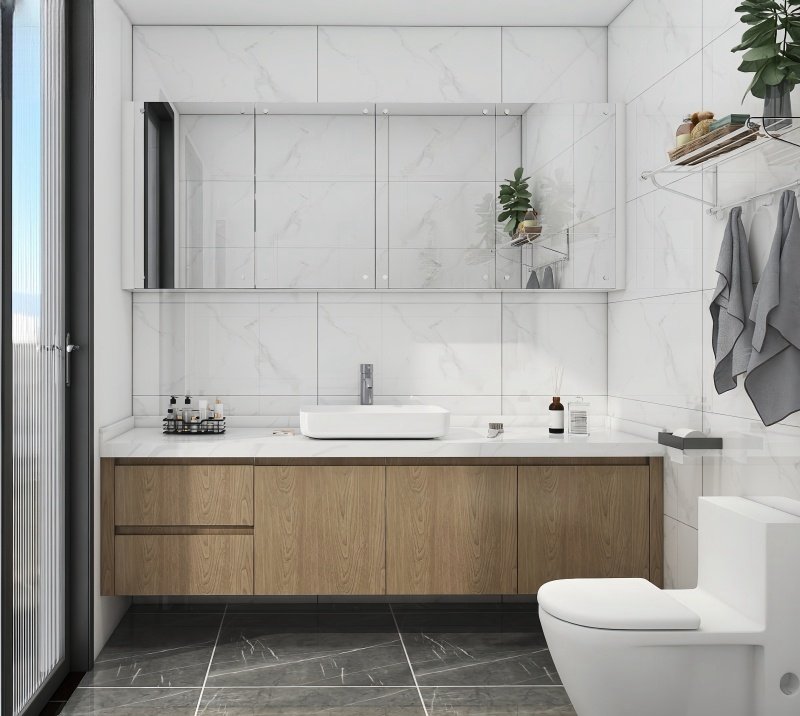When it comes to bathroom design, the choices you make can greatly impact the functionality and aesthetics of the space. Two of the most important components in a bathroom are the vanity and the basin. While they may seem similar at first glance, they serve different purposes and offer different advantages. Today, we’re going to explain the main differences between vanities and basins to help you make an informed decision for your bathroom renovation or design project.
What is a Vanity?
A vanity is a piece of bathroom furniture that combines a sink, countertop, and storage space. It is designed to be both functional and stylish, providing a place to store toiletries, towels, and other bathroom essentials while also housing the sink. Vanities come in various sizes, styles, and materials, making them a versatile choice for any bathroom design.

Key Features of Vanities:
- Storage Space: One of the primary functions of a vanity is to provide storage. Vanities typically include cabinets, drawers, or shelves that can be used to store toiletries, cleaning supplies, and other bathroom items.
- Countertop: The countertop provides a surface for placing items such as soap dispensers, toothbrush holders, and decorative elements. Countertops can be made from various materials, including marble, granite, quartz, and laminate.
- Integrated Sink: Most vanities come with an integrated sink, which is either built into the countertop or set into it. This integration helps create a seamless and cohesive look.
- Aesthetic Appeal: Vanities are available in a wide range of styles, from traditional to modern, allowing homeowners to choose a design that complements their bathroom décor. They can be freestanding or wall-mounted, depending on the available space and desired look.
- Customization: Many vanities can be customized with different finishes, hardware, and countertop materials, offering a high level of personalization.
What is a Basin?
A basin, also known as a sink, is a standalone fixture designed for washing hands, face, and other personal hygiene tasks. Basins can be installed in various ways, including wall-mounted, pedestal, countertop, and undermount. Unlike vanities, basins do not typically include storage space or additional countertop areas.

Key Features of Basins:
1. Standalone Fixture: Basins are primarily designed as standalone fixtures without built-in storage. They focus on providing a functional and accessible washing area.
2. Installation Types: Basins can be installed in several ways:
- Wall-Mounted: These basins are attached directly to the wall, saving floor space and offering a minimalist look.
- Pedestal: Pedestal basins sit on a pedestal that supports the basin and conceals the plumbing. They have a classic and elegant appearance.
- Countertop: These basins sit on top of a counter or vanity surface, adding a stylish and modern touch to the bathroom.
- Undermount: Undermount basins are installed beneath the countertop, creating a sleek and seamless look.
3. Material Variety: Basins are made from a variety of materials, including ceramic, porcelain, glass, stainless steel, and stone. Each material offers different benefits in terms of durability, appearance, and maintenance.
4. Aesthetic Versatility: Basins come in numerous shapes, sizes, and styles, allowing homeowners to choose a design that fits their bathroom’s overall look. From round to rectangular, there are plenty of options to suit different preferences.
5. Space Efficiency: Basins are ideal for small bathrooms or powder rooms where space is limited. They can be paired with other storage solutions to maximize functionality.
Key Differences Between Vanities and Basins
While both vanities and basins serve as essential bathroom fixtures, they differ in several key aspects:
1. Functionality:
- Vanity: Combines a sink with storage and countertop space, providing a multifunctional solution.
- Basin: Primarily serves as a washing area without additional storage or countertop features.
2. Storage:
- Vanity: Offers integrated storage options such as cabinets, drawers, and shelves.
- Basin: Does not include built-in storage, requiring separate storage solutions.
3. Installation:
- Vanity: Can be freestanding or wall-mounted, often requiring more space for installation.
- Basin: Can be wall-mounted, pedestal, countertop, or undermount, offering more flexibility in placement.
4. Aesthetic Appeal:
- Vanity: Provides a cohesive and often luxurious look with integrated components.
- Basin: Offers a minimalist and versatile aesthetic with various installation styles and materials.
5. Space Requirements:
- Vanity: Typically requires more space due to the combination of sink, countertop, and storage.
- Basin: Ideal for small bathrooms, powder rooms, or spaces with limited floor area.
Choosing Between a Vanity and a Basin
When deciding between a vanity and a basin, consider the following factors:
- Bathroom Size: If you have a small bathroom or powder room, a basin might be a more suitable choice due to its space-saving design. For larger bathrooms, a vanity can offer additional storage and countertop space.
- Storage Needs: Assess your storage requirements. If you need ample storage for toiletries and other bathroom essentials, a vanity with integrated cabinets and drawers is the better option. If storage is not a priority, a basin can suffice.
- Design Preference: Think about the overall style and design of your bathroom. Vanities provide a more cohesive look with integrated elements, while basins offer a versatile and minimalist aesthetic.
- Budget: Consider your budget for the bathroom renovation. Vanities can be more expensive due to their multifunctional design and additional materials, while basins are generally more budget-friendly.
- Installation and Maintenance: Factor in the installation process and maintenance requirements. Vanities may require more complex installation and ongoing maintenance due to their integrated components, while basins are typically easier to install and maintain.
Conclusion
In conclusion, vanities and basins are both essential bathroom fixtures, each offering unique benefits and serving different purposes. Vanities combine functionality and aesthetics with integrated storage and countertop space, making them ideal for larger bathrooms. Basins, on the other hand, provide a straightforward and versatile solution for washing, perfect for small spaces or minimalist designs. By understanding the key differences between vanities and basins, you can make an informed decision that suits your bathroom’s needs and enhances its overall look and functionality.
FAQs
Q1. What is a vanity?
A1:
A vanity is a bathroom furniture combining a sink, countertop, and storage.
Q2. What is a basin?
A2:
A basin is a standalone fixture for washing, also known as a sink.
Q3. What are the key differences between a vanity and a basin?
A3:
Vanities offer storage and countertop space, while basins are standalone fixtures without built-in storage.
Q4. Which spaces are vanities and basins suitable for?
A4:
Vanities suit larger bathrooms with extra storage needs. Basins are ideal for small bathrooms or spaces with limited area.
Q5. What are the common installation types for basins?
A5:
Basins can be wall-mounted, pedestal, countertop, or undermount.




